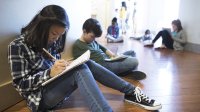Guiding Students to Be Independent Learners
Three strategies for helping students become self-motivating and take charge of their learning.
It’s estimated that students in the U.S. spend nearly 20,000 hours experiencing classroom education by the age of 18, and that much of what is taught is forgotten within a short time. And there’s little evidence that they know how to apply effective learning strategies when they arrive at college.
In essence, many students have not learned how to retain and apply knowledge. Fortunately, current research offers fascinating insights about the brain’s capacity to learn at higher levels when effective learning strategies are used.
In the quickly evolving workplace and at a time when graduates are competing for jobs and careers with others around the world, the capacity to change rapidly and apply new skills is paramount. Bottom line: Learning how to learn is a game changer in the global knowledge economy, and it’s never too early to teach students how to begin to learn more independently.
Cultivating Independent Learners
Inspire student motivation for learning: Motivation to learn is key to success in school, after graduation in the global job market, and for life in a world of constant changes in technology.
Use the power of your relationship with students to show a passion for learning. When you embody passion for learning, your students are more likely to have a powerful, positive emotional connection to learning that will inspire their motivation to continue to learn. With teachers who release their passion for learning, students across all grades are free to learn new ways of learning with motivation and joy. Over time, expect self-motivation rather than compliance.
Guide students to imagine how they will feel when they learn something new. Allow volunteers to describe their feelings after they learned something. When appropriate, ask students to visualize what a finished project will look like.
Encourage students to tell a friend their learning goal and get their support. This allows students to verbalize their goal, which will help them internalize it. Students of all ages are inherently social, and getting support from a peer can be very motivating.
Coach students to set goals and develop a plan for learning: Support students in developing their own learning goals that are realistic yet challenging. Often the most motivating goals are those that allow us to use our personal strengths. Yet students often have goals set for them based on a one-size-fits-all curriculum or on their personal learning deficits—think individualized education program—which can be discouraging.
If you have students who currently lack motivation to learn, consider helping them to develop learning goals based on their personal learning strengths. For example, a personalized goal for some learners might be to design movement breaks for the class. Another student might set a goal to complete his or her appreciation or gratitude journal with photographs or illustrations. For another student, Pinterest offers ideas that might aid them in becoming curious about new topics to learn about. Teachers can support students in becoming aware of their strengths and figuring out how to set personal goals.
Teach students how to best structure their independent learning time. Our brains did not evolve to do several hours of physics without a break. We encourage students to plan a shift in focus after every 20 minutes of independent study. At least every hour or so, they should get up and move. When learning new material, they should utilize different locations. For example, we use an outside patio table, a particularly comfortable chair, an inside office desk, and different local cafes as places to work. Because memory for locations is powerful, using several locations for learning aids memory.
Encourage students to become self-disciplined learners. Support them in making a commitment to themselves to get started on achieving their goals. Assist them in affirming their commitment to organize themselves, manage their focus over time, and limit time-wasting distractions. Help students learn to consistently define themselves as people who commit to and achieve their goals. It will probably be necessary to remind them time and again that along the learning pathway, successful people forgive themselves when they make mistakes and then continue on.
Teach students to self-assess: Ask students to write a letter to a student who will be in the class the next year. Upon completion of a project, unit, or chapter, ask students to summarize what they have learned and tell the future student how they have overcome any learning challenges. This strategy provides an opportunity for student reflection on virtually any topic.
Have students pair up and take turns sharing what they have learned. This activity—we call it “brain buddies”—gives students opportunities to learn from each other. For example, each partner may remember different aspects of a lesson. And they may have different points of view, so when they share, each partner can learn to better understand a variety of perspectives.
As your students practice independent learning, encourage them to notice changes. For example, when we asked students to discuss changes in achievement, one student said, “Now I get assignments turned in on time, and my grades have improved.” Another said, “I enjoy school now because I know how to make better grades.” Over time, statements like these become a part of students’ positive identity for school success.
